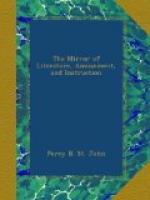“dancing in the air.” The very same
effect is perceived when we look at objects through
spirits and water that are not perfectly mixed, or
when we view distant objects over a red hot poker
or over a flame. In all these cases the light
suffers refraction in passing from a medium of one
density into a medium of a different density, and the
refracted rays are constantly changing their direction
as the different currents rise in succession.
Analogous effects are produced when sound passes through
a mixed medium, whether it consists of two different
mediums or of one medium where portions of it have
different densities. As sound moves with different
velocities through media of different densities, the
wave which produces the sound will be partly reflected
in passing from one medium to the other, and the direction
of the transmitted wave changed; and hence in passing
through such media different portions of the wave
will reach the ear at different times, and thus destroy
the sharpness and distinctness of the sound. This
may be proved by many striking facts. If we put
a bell in a receiver containing a mixture of hydrogen
gas and atmospheric air, the sound of the bell can
scarcely be heard. During a shower of rain or
of snow, noises are greatly deadened, and when sound
is transmitted along an iron wire or an iron pipe
of sufficient length, we actually hear two sounds,
one transmitted more rapidly through the solid, and
the other more slowly through the air. The same
property is well illustrated by an elegant and easily
repeated experiment of Chladni’s. When sparkling
champagne is poured into a tall glass till it is half
full, the glass loses its power of ringing by a stroke
upon its edge, and emits only a disagreeable and a
puffy sound. This effect will continue while the
wine is filled with bubbles of air, or as long as the
effervescence lasts; but when the effervescence begins
to subside, the sound becomes clearer and clearer,
and the glass rings as usual when the air-bubbles
have vanished. If we reproduce the effervescence
by stirring the champagne with a piece of bread the
glass will again cease to ring. The same experiment
will succeed with other effervescing fluids.—Sir
David Brewster.
* * * * *
No man is so insignificant as to be sure his example can do no hurt.
—Lord Clarendon.
* * * * *
THE PUBLIC JOURNALS.
* * * * *
PADDY FOOSHANE’S FRICASSEE.
Paddy Fooshane kept a shebeen house at Barleymount Cross, in which he sold whisky—from which his Majesty did not derive any large portion of his revenues—ale, and provisions. One evening a number of friends, returning from a funeral—–all neighbours too—stopt at his house, “because they were in grief,” to drink a drop. There was Andy Agar, a stout, rattling fellow, the natural




